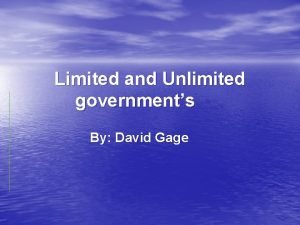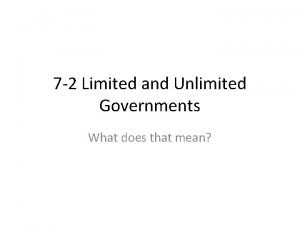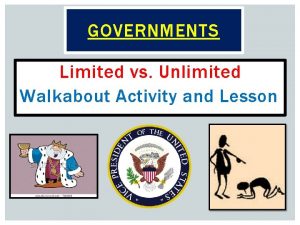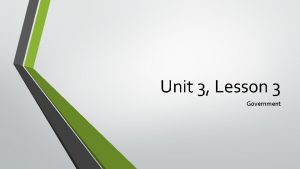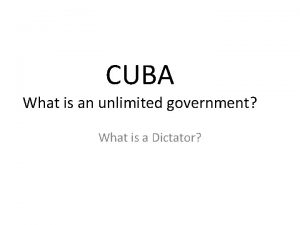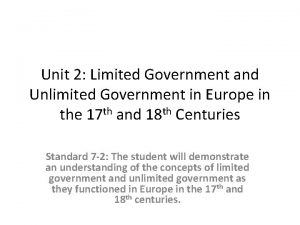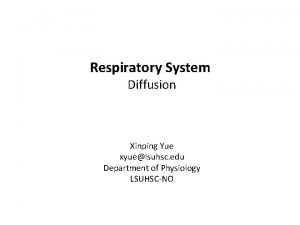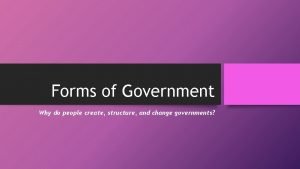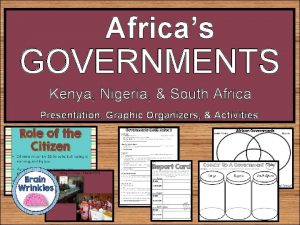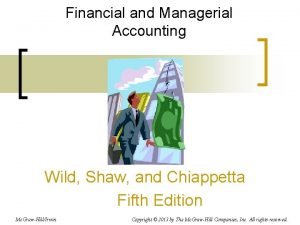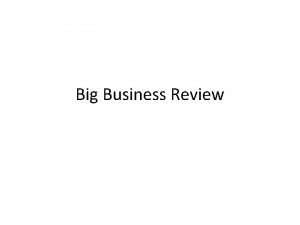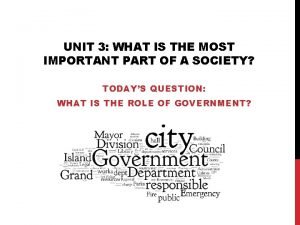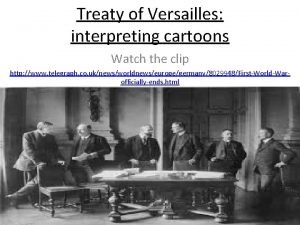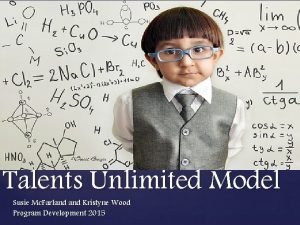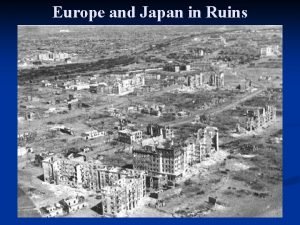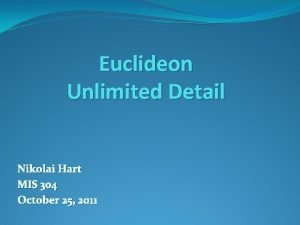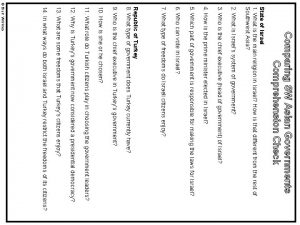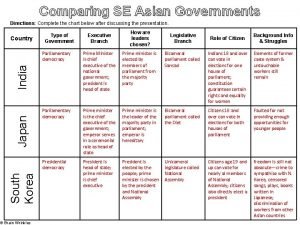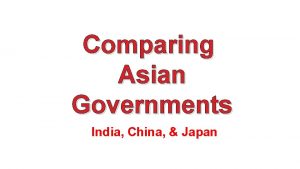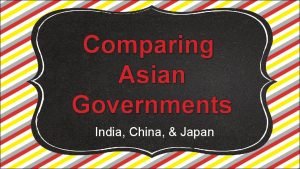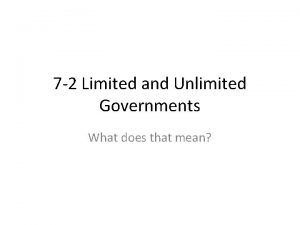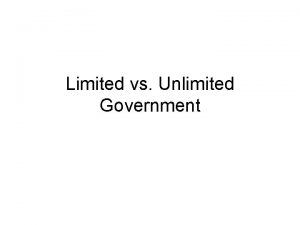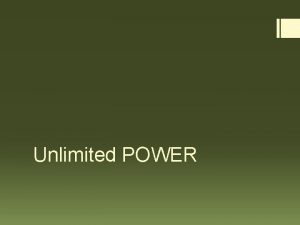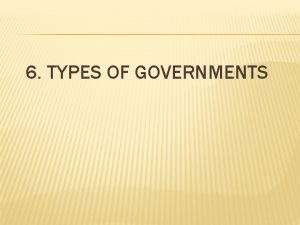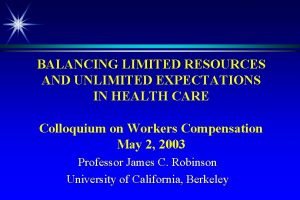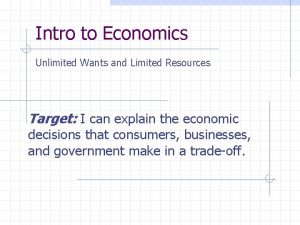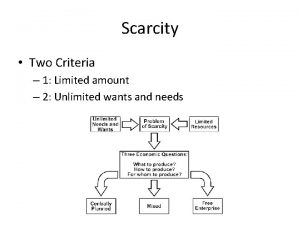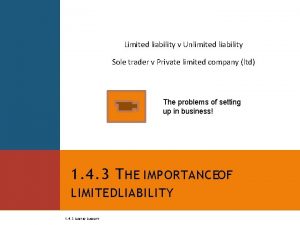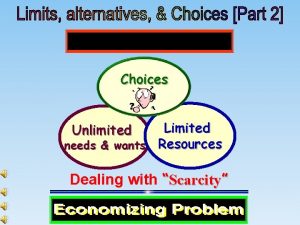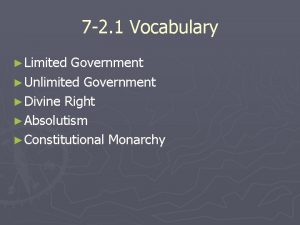7 2 Limited and Unlimited Governments What does





















- Slides: 21

7 -2 Limited and Unlimited Governments What does that mean?

In the 1600 s and 1700 s… • Monarchies, or governments, led by kings or queens, ruled much of Europe • Monarchs favored a system of Absolutism. • Absolutism places absolute or total power in the hands of a ruler and his/her advisers.

Limited VS. Unlimited Limited Government Unlimited Government • Power of the government is restricted by the people • Basis of American democracy • Monarchs (kings or queens) had absolute and total control • The people had no say whatsoever. • They were justified by divine right= rulers receive their power directly from God and are responsible only to God.

England King/Queen Timeline • From the Plantagenet family… • King John I- 1199 -1216 – Responsible for the Magna Carta (Great Charter, 1215) giving justice to all. The Magna Carta limited the government of England gave the people certain rights for the first time…ex. Trial by jury. – Before John signed the Magna Carta, he was an absolute monarch.

King Edward I 1272 - 1307 • Edward formed the Model Parliament in 1295. It included representatives that spoke for the people. This group, called Parliament, was a stepping-stone for self-government. • Parliament was later divided into two: • 1. Nobles/High Church Officials- House of Lords • 2. Townspeople- House of Commons • Parliament had control over taxation and funds voted to the crown. • King Edward II 1307 – 1327

King Edward III 1327 - 1377 • The House of Lords was created under Edward III separating elected members or “commoners” from Lords and Bishops. • 1348 - The outbreak of bubonic plague, the 'Black Death' in 1348 -1350 killed half the population of England. • 1337 -1453 The Hundred Years War with France

Richard II 1377 - 1399 • End of the Plantagenets (family) ___________________

House of Lancaster • Henry IV 1399 – 1413 • Henry V 1413 – 1422 • Henry VI 1422 - 1461, 1470 - 1471 – War of the Roses began; war between the Lancaster family and the York family. – Left the throne bc of mental breakdown…was restored in 1470.

House of York • King Edward IV 1461 -1470, 1471 - 1483 • King Edward V 1483 - 1483 • King Richard III 1483 – 1485

The Tudors • King Henry VII 1485 - 1509 • King Henry VIII 1509 - 1547 – Had six wives – First wife was Catherine of Aragon (Spanish) – Wanted to marry someone else; Pope said no. He then declared himself the new head of the “New Church of England. ” – Granted his own divorce. – Had three children (one illegitimate) • Mary (from Catherine of Aragon) = Spanish/Catholic • Elizabeth

The Tudors • King Edward VI 1547 – 1553 • Queen Mary I (Bloody Mary) 1553 - 1558 – Married Philip II of Spain – Got her name from the thousands of people she murdered when she turned Protestant England back to the Catholic faith.

The Tudors • Queen Elizabeth I 1558 - 1603 – During her reign great adventurers discovered many new lands. Fought off the Spanish Armada. – She never married, so power was passed to James I, the son of Elizabeth’s cousin. – James was a member of the Stuart family, who believed in divine right.

The Stuarts • James I 1603 – 1625 – Believed in divine right. – Would not tolerate anyone questioning his power as King. – Catholic – Angered many people • Sold titles (Duke/Duchess) to raise money • Told Puritans that he would force them out of the land ***After his death, England was in Civil War***

The Stuarts • Charles I 1625 - 1649 – Fought against the Parliament leading to civil war. – 1628, Parliament enacts the Petition of Rights. Banned the king from doing the following: • Passing taxes without the consent of Parliament. • Quartering troops in private homes • Imprisoning people without charges 1642 - Charles ignores the petition and favors Catholics. ***Oliver Cromwell organizes a parliamentary war. The conflict between the king and the parliament starts the civil war***

English Civil War 1642 -1651 • 1646 - Parliament wins complete control. • 1647 - Charles I is executed. Puritans end monarchy and House of Lords. 1649 -1659 -Try to set up a commonwealth, state ruled by elected representatives= fail. When this fails, Cromwell imposes Martial Law. 1658 - Richard Cromwell takes over the government. 1660 - Parliament sick of Puritan rule; restores the monarchy---- This is called the restoration.

The Restoration • Charles II 1660 – 1685 – Protestant – Left no children, so his Catholic brother took over. • James II 1685 – 1688 – Tried to force people to follow Catholic faith 1688 - Parliament fears the return of Catholic monarchy. Invites James’ Protestant daughter Mary and her husband William to take throne.

Glorious Revolution • William III 1688 - 1702 and Queen Mary II 1688 – 1694 – Protestant – Take over monarchy in a bloodless invasion – Forced to sign the English Bill of Rights of 1689, which limits the monarchy and states the rights of Parliament and the people. – Rule as limited monarchs.

The English Bill of Rights of 1689 • Ended divine right • Created constitutional monarchy- monarchy ruled by an assembly and limited by law. • P. 64 in workbook – Highlight Bill of Rights Points – (You will need to be familiar with these points)

Unlimited Governments • King Louis XIV of France – Model for absolutism – Known as the Sun king bc everything revolved around him – “I Am The State” – Banned the Estates-General – Overruled the Edict of Nantes – Palace of Versailles (Hall of Mirrors) – Left France in debt

Unlimited Governments • Russia: – Peter I, or “Peter the Great” ruled Russia from 1689 -1725 – Title of Czar – Believed in divine right; looked to France for a guide. – Used power to strengthen Russia; he westernized Russia.

Unlimited Governments • Catherine II of Russia… “Catherine the Great” • Expanded Russian empire • Last of Europe’s major monarchs
 Is canada a limited or unlimited government
Is canada a limited or unlimited government Limited vs unlimited government
Limited vs unlimited government Unlimited vs limited government
Unlimited vs limited government Unit 3 lesson 3
Unit 3 lesson 3 What is unlimited government
What is unlimited government Is india a limited or unlimited government
Is india a limited or unlimited government Perfusion vs diffusion limited
Perfusion vs diffusion limited Why do people create, structure, and change governments?
Why do people create, structure, and change governments? How do the governments of kenya and nigeria compare?
How do the governments of kenya and nigeria compare? When demand is unlimited and products use the same inputs
When demand is unlimited and products use the same inputs During the late 1800s the defenders of social darwinism
During the late 1800s the defenders of social darwinism Yahoo mail
Yahoo mail Different kind of governments
Different kind of governments Indicates
Indicates Unlimited virtual smp
Unlimited virtual smp Calvin taylor creative thinking model
Calvin taylor creative thinking model Note 3 ways war affected the land and people of europe
Note 3 ways war affected the land and people of europe Euclideon engine
Euclideon engine Se asia governments comprehension check
Se asia governments comprehension check Comparing asian governments
Comparing asian governments Comparing asian governments
Comparing asian governments Comparing asian governments
Comparing asian governments
